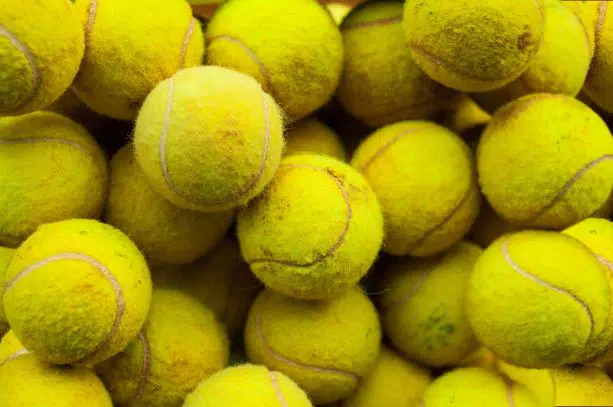Modern regulation tennis balls contain internal air pressure for consistent bounce. But non-pressurized balls without this air pocket offer contrasting qualities. Here are 11 differences between pressurized and non-pressurized tennis balls:
- Bounce – Pressurized balls bounce higher and more consistently.
- Speed – Pressurized balls can be struck harder and faster off the racket.
- Materials – Pressurized balls have a rubber core and felt coats. Non-pressurized are often all-rubber.
- Weight – Pressurized balls are lighter around 57-59g. Non-pressurized are slightly heavier.
- Size – Both around 6.5-6.7cm diameter.
- Durability – Non-pressurized balls last much longer. Pressurized balls go flat.
- History – Pressurized originated 1930s. Non-pressurized used before.
- Compression – Pressurized balls compress 1.4-1.6cm on bounce. Non-pressurized compress less.
- Temperature – Colder temperatures reduce pressurized ball bounce. Minimal effect on non-pressurized.
- Brands – Wilson, Penn make top pressurized balls. No major brands for non-pressurized.
- Cost – Non-pressurized much cheaper, as low as $1/ball. Pressurized around $4/ball retail.
Below we’ll detail the specialized engineering in each that tailors them for different playing characteristics and environments. Let’s dig into the science inside the ball!

Difference in Bounce
The key difference is that pressurized balls have a much livelier, consistent bounce thanks to their inflated interior pocket of compressed air. This air pressure gives great rebound off the racket and court.
Non-pressurized balls lack that internal air pocket, so undergo less deformation on impact. This results in a flat, inconsistent bounce with more energy absorption rather than rebound.
I could really feel the weak, dull bounce trying to rally with non-pressurized balls after getting used to lively pressurized ones!
Difference in Speed
Thanks to their bouncy pressurized core, pressurized balls can be struck with more force and reach faster speeds off the racket due to efficient energy return.
Non-pressurized balls don’t have the same energy return, limiting ball speed potential. They slow down faster through the air and off the court surface.
My rally pace suffered noticeably when I’d try non-pressurized balls that wouldn’t keep zinging off my racket sweet spot the same way.
Difference in Materials
Modern regulation pressurized tennis balls feature a hollow rubber core enclosing compressed air, wrapped in a fuzzy felt exterior made of hair and fibers.
Non-pressurized balls are often solid rubber construction with no inflation. Some include felt coats while cheap versions may just have a basic matte rubber exterior.
So pressurized balls use advanced materials tailored for consistent bounce. Non-pressurized balls take a simpler, more durable construction.
Difference in Weight
Pressurized balls are lighter, averaging 57-59 grams to enhance speed and bounce potential.
The solid non-pressurized rubber balls come in slightly heavier around 60-65 grams generally.
That lighter-weight pressurized profile really maximizes racket head speed for faster shots.
Difference in Size
Both pressurized and non-pressurized tennis balls adhere to the international size standard of 6.5-6.7cm diameter.
This consistent size allows usage across different racket heads and string beds for reliable contact and response.
So whether pressurized or not, standardized sizing applies.
Difference in Durability
This is a major contrast – pressurized balls quickly lose compression and go “flat” as the fuzzy felt wears down and interior air escapes. They need replacing often when used extensively.
Non-pressurized solid rubber balls can last vastly longer with less concern about losing inflation and exterior condition over time. The solid construction endures heavy use for years if cared for.
I’d definitely get months more play out of non-pressurized balls before performance deteriorated noticeably. Pressurized balls lost their zip in weeks.
History of Both Types
Non-pressurized solid rubber balls were used in tennis historically up through the late 1800s.
The pressurized interior air pocket enclosed by a fuzzy felt coat was developed in the 1930s, allowing for livelier bounce and speed.
So non-pressurized balls preceded pressurized, until air inflation improved bounce characteristics.
Difference in Compression
When dropped from 100 inches onto concrete, a pressurized ball compresses between 1.4-1.6cm before rebounding thanks to the internal air pressure and felt deformation.
Non-pressurized balls compress less than 1cm generally on the same concrete drop test. Their solidity doesn’t absorb force as effectively.
That compression really translates to efficient energy return for lively pressurized balls on shots!
Temperature and Bounce
Colder temperatures reduce the internal pressure in pressurized balls, diminishing bounce potential slightly.
Non-pressurized balls are less affected by temperature variations since they lack internal air pressure.
So pressurized balls must be kept in proper conditions to maintain lively inflation and bounce.
Brands and Manufacturers
Wilson, Penn, Dunlop, and other major sporting brands are renowned for their pressurized tennis ball quality.
There are no prominent brands producing non-pressurized balls, which are often cheap homemade rubber balls.
Top brands optimize state-of-the-art pressurized ball engineering.
Cost Considerations
A can of 3 quality pressurized balls from a leading brand costs around $5 on average. Per-ball cost is $1.50-$2 at retail.
Basic non-pressurized rubber balls can be found for as low as $1 per ball in bulk cases. Their no-frills construction brings costs down.
So pressurized is pricier but non-pressurized offers serious budget savings.
In summary, pressurized and non-pressurized tennis balls diverge substantially in their materials, bounce, speed, durability and cost considerations. Pressurized balls deliver high performance for competitive play, while non-pressurized offer accessibility and affordability with recreational functionality. Understanding these specialized ball profiles illuminates the technology and engineering inside!
If you’re looking for more info between the two types of balls, I found the following podcast clip incredibly detailed! (for all you tennis ball geeks out there):
